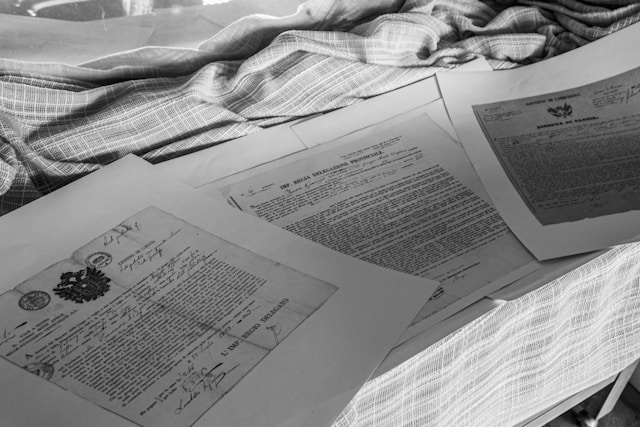
The principal difference between a deed and written contracts is that additional formalities beyond a simple signature are required for the document to be enforceable as a deed. These are:
Writing. A deed must be in writing. This is a common law requirement modified by section 1(1)(a) of the Law of Property (Miscellaneous Provisions) Act 1989 (LP(MP)A).
Face value requirement. It must be clear from the face of the document that it is intended to take effect as a deed.
Execution. The instrument must be validly executed as a deed by the person(s) making it.
Delivery. A deed must be “delivered” – the purpose of which is to signify that the maker of the deed intends it to become effective and that it binds them. A deed becomes binding on the date of delivery, not from the date of its execution. Delivery of a deed can be conditional or unconditional.
There are also many instances in which the use of a deed over a contract or any other form of agreement is essential which is why it is so important to ensure that these requirements, although seemingly simple enough, must be complied with. The most common of these instances are in relation to gratuitous promises (where there is no consideration) and powers of attorney, and the most common mistakes made in relation to the formalities of a deed are made in connection with the execution of a deed.
English law does not demand that the execution clause in a deed follows a particular structure or includes specific language (although HM Land Registry does specify certain requirements). However, following usual practice, by expressly stating in or above the execution block that the document is being executed “as a deed”, satisfies the “face value requirement” above.
Section 1(3) of the LP(MP)A 1989 provides that:
“An instrument is validly executed as a deed by an individual if, and only if:
(a) it is signed:
(i) by him in the presence of a witness who attests the signature; or
(ii) at his direction and in his presence and the presence of two witnesses who each attest the signature; and
(b) it is delivered as a deed by him or a person authorised to do so on his behalf.”
So the usual form and content of the execution clause can also help ensure that any applicable signature formalities are observed (for example, the requirement for attestation by a witness in the case of execution of a deed by an individual):
Signed as a deed by [NAME ]) …………………………………
in the presence of: )
[SIGNATURE OF WITNESS]
……………………………………………………
[NAME, ADDRESS [AND OCCUPATION] OF WITNESS]
While including a witness’ information is not a legal requirement, it is best practice to do so, as it may help locating and contacting the witness should any issues subsequently arise concerning the validity of, or the circumstances surrounding, the execution of the deed.
But what is involved in “attesting” a signature? There is no statutory guidance or requirement, but it is generally accepted that, in the context of executing a deed, attestation involves two elements:
- The witness observes the document being signed by the maker of the deed; and
- The witness then signs the deed themselves and if the execution block is as set out above, there is a presumption that the deed was signed by the maker in the presence of the witness.
It is important to note that witnessing involves neither vouching for the identity of the signatory nor anything in relation to the contents of the deed. However, the identity of the witness is important: signatories to a deed should never attest each other’s signatures, for example.
While these requirements seem archaic, they have kept up with technology.
It is possible validly to execute a deed using an electronic signature, and equally, it is possible for the witness to apply an electronic signature to attest their act of witnessing the maker of the deed apply their own electronic signature.
BUT – to satisfy the LP(MP)A requirement that the maker’s electronic signature is applied in the presence of the witness, both parties must be in the same room. Physical presence is a prerequisite, and this applies equally to wet ink signature.
If a document purporting to be a deed fails to meet the above-mentioned requirements such that it is not a deed, there can be significant implications. For example, it may affect the enforceability of a gratuitous promise made without valuable consideration and impact the limitation period.
Key do’s and don’ts
DO
- Ensure that the witness is in the physical presence of the maker of the deed when they sign it.
- Make sure that if there are any alterations to be made to the deed, they are made before anyone signs it, and that all alterations are initialed by the maker and the witness and any other party to the deed.
- Include a counterparts clause if necessary so that different parties can each execute an identical version of the deed to create a complete instrument.
- Ensure that the governing law of the document being executed as a deed recognises the concept of deeds (for example, Jersey and Guernsey do not).
DON’T
- Ever back date a deed. As we have seen, a deed takes effect from delivery and not from the date on the face of the deed (if different).
- Amend the deed after it has been executed.
Fn1 Para 2.6 – Law Commission’s 1988 Consultation paper on the execution of deeds and documents
If you would like further information please get in touch with your usual contact at MTG, or email info@mtgllp.com.
Eleanor Thompson
Associate
Eleanor Thompson is an Associate at Maurice Turnor Gardner.
Sophie Mazzier
Counsel
Sophie Mazzier has more than 30 years’ experience in Private Wealth advice and provides both technical and practical professional legal support to the firm.






